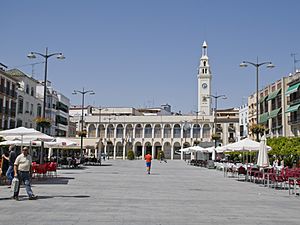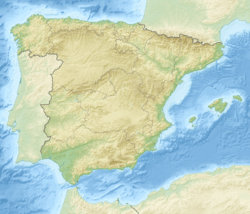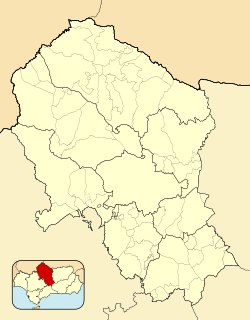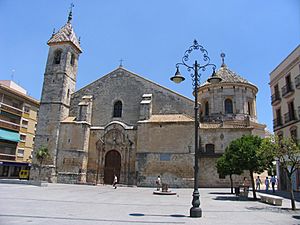Lucena, Córdoba facts for kids
Quick facts for kids
Lucena
|
|||
|---|---|---|---|
 |
|||
|
|||
| Country | Spain | ||
| Autonomous community | Andalusia | ||
| Province | Córdoba | ||
| Area | |||
| • Total | 351 km2 (136 sq mi) | ||
| Elevation | 485 m (1,591 ft) | ||
| Population
(2018)
|
|||
| • Total | 42,530 | ||
| • Density | 121.17/km2 (313.8/sq mi) | ||
| Demonym(s) | Lucentinos | ||
Lucena is a lively town in Spain. It's located in the province of Córdoba, which is part of the sunny region of Andalusia. Lucena is the second-biggest town in its province by population.
For a long time, from the 800s to the 1100s, Lucena was a very important center for Jewish people. Most of its residents during that time were Jewish.
Contents
Lucena's Location
Lucena is found in a special area where two different landscapes meet. It sits between the flat campiña (a type of countryside) of the Guadalquivir Depression and the mountains of the Subbaetic System.
The town is about 485 meters (around 1,591 feet) above sea level. Nearby mountains include the sierras of Cabra, Carcabuey, Pollos, Horconera, and Rute.
A Look at History
Lucena's story really begins during the time of Islamic rule in Spain. The town was first mentioned in a document from 853. It was described as "a city of many Jews" with no non-Jewish people living there. Old gravestones found in Lucena's Jewish cemetery also suggest a Jewish community existed here around the 800s and 900s.
During Islamic rule, Lucena was part of the district of Cabra. By the 900s, Lucena's Jewish community was almost as important as the one in Córdoba. When the Caliphate of Córdoba fell apart in the 1000s, Lucena became part of the Zirid Kingdom of Granada.
Famous Jewish Scholars
In the early 1000s, many important Jewish scholars lived in Lucena. Isaac Alfasi started a big school for studying the Talmud (a central text of Judaism) here. Other famous scholars like Isaac ibn Ghayyat, Isaac ibn Albalia, and Joseph ibn Migash also lived and worked in Lucena.
However, the number of Jewish people in Lucena dropped sharply when new rulers, the Almoravids and later the Almohads, took over. Many Jewish residents either moved to Christian areas in northern Spain (like Toledo), were forced to change their religion, or were taken as captives to North Africa. The Almohads conquered Lucena in 1148. After this, Lucena was no longer a major Jewish center.
Christian Rule and Growth
The Christian kingdom of Crown of Castile took control of Lucena in 1240. It was given to the Bishop of Córdoba in 1241. Lucena stayed under the bishop's control until 1342. Then, it became a royal possession. In 1344, it was given special rights, similar to those of Córdoba.
For the rest of the Middle Ages, Lucena was a border town near the Nasrid Kingdom of Granada. In the late 1300s, it became owned by a powerful family, the Fernández de Córdoba.
After the Granada War ended in 1492, Lucena grew a lot. Its population jumped from 1,300 people in 1495 to about 8,172 in 1530. Many families who had recently converted to Christianity moved to Lucena, helping the town grow. Lucena was officially named a "city" in 1618.
Local Industries
Today, Lucena is known for making furniture, industrial refrigerators, wine, and bronze lamps. It also produces pottery, especially large earthenware jars called tinajas. These jars were once used all over Spain to store oil and wine. Some could hold more than 300 gallons! Lucena also has a lot of trade in farm products.
Easter Celebrations: Semana Santa
Easter, known as Semana Santa (Holy Week) in Spain, is the most important yearly celebration in Lucena. Lucena's Semana Santa is famous for its special and unique way of carrying the "pasos" or processions. These "pasos" are large floats that carry sculptures, often hundreds of years old.
The "Santería" Tradition
In Lucena, the "pasos" are carried on the shoulders of people, a tradition called "santería." Unlike other places in Andalusia, the porters in Lucena carry the floats with their faces uncovered and at the same height. This unique way of carrying processions is a special part of Lucena's culture.
You can best experience "santería" on Easter Thursday (Jueves Santo), when nine "pasos" parade through the streets. Two famous sculptures are the Cristo de la Columna, made by the well-known artist Pedro Roldán in 1675, and the impressive Cristo de la Sangre, which came from the Americas in the early 1600s.
Highlights of Holy Week
The best days to see Semana Santa in Lucena are Palm Sunday, Tuesday, Thursday, and Saturday.
- Palm Sunday: Five "pasos" from three different churches come together to form one big procession. Highlights include the Cristo de la Bondad and the Madonna de la Estrella.
- Monday: This day is dedicated to one group, the Franciscan brothers. Their "pasos" are kept at a beautiful Franciscan convent. Don't miss the Medinaceli Christ and the Virgen de Piedra.
- Tuesday: Three different groups and seven "pasos" are on the streets. The Carmine group, founded in 1606, has very old and unique "pasos" like the "Virgen de los Dolores." The "Peace & Love" group, based at St. Matthew's Cathedral, features the beautiful "Madonna of Peace & Love."
- Wednesday: This is a quieter day with only one group, "El Valle," and two "pasos." But it leads into the most traditional day, "Jueves Santo."
- Thursday (Jueves Santo): At midnight, the "Cristo del Silencio" leaves St. Matthew's Cathedral in complete silence and darkness. This is a very special moment. Later in the afternoon, another group starts its procession with unique "pasos" like the "Holy Faith Allegory" and "Jesus washing St Peter's feet." The most awaited moment is when the "Cristo de la Columna" leaves St. Jacques church. People sing "saetas" (flamenco-style prayers) as the "paso" moves. The "Cristo de la Sangre" also processes from St. Francis church. All nine "pasos" meet in Alcaide street Las Torres before heading to Plaza Nueva (Main Square).
- Good Friday: There's only a short break between Thursday and Good Friday. The Nazareno Christ comes out at 6:00 am. This group, founded in 1599, has six "pasos" and is one of the oldest in town.
- Saturday: Only one group, the "Soledad," processes with one "paso." This is the oldest group in Lucena, formed in 1564. It's a very well-organized and serious procession.
- Sunday: The "Resurrection" group marks the end of the week-long celebrations.
Notable People from Lucena
Many interesting people have connections to Lucena:
- Isaac ibn Ghiyyat (1038–1089): A famous Jewish scholar.
- Joseph ibn Migash (1077-1141): A respected rabbi and leader of a Jewish school who lived most of his life in Lucena.
- Luis Ramírez de Lucena (1465-1530): A leading Spanish chess player who wrote the oldest printed book about chess. A famous chess position, the Lucena position, is named after him.
- Luis Barahona de Soto (1548-1595): A poet and friend of the famous writer Miguel de Cervantes.
- Antonio Mohedano (1561-1625): A painter from the Renaissance period.
- Francisco Hurtado Izquierdo (1699-1725): An architect known for his work on the Granada Charterhouse.
- José María Hinojosa, "El Tempranillo" (1805-1833): A famous Spanish bandit, known as a bandolero.
- Paco de Lucena (1859-1898): A well-known flamenco guitarist.
- Victor Perez (Director) (born 1981): A Spanish director, producer, and digital film artist.
Images for kids
See also
 In Spanish: Lucena para niños
In Spanish: Lucena para niños









